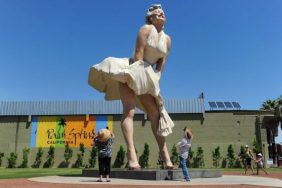“Maybe I’ll never be able to do what I hope to, but at least I have hope.” – Marilyn Monroe
Writer/director Liz Garbus has earned largely positive critical acclaim for her documentary, What Happened, Miss Simone?, an empathetic, exhaustively researched look at the art and life of the late singer/songwriter/civil rights activist Nina Simone. The film is brutally compelling, foregoing the hagiography many projects like this succumb to and instead presenting a woman who not only battled all manners of darkness (political, cultural, marital, existential…) but doled it out as well. By illuminating the flawed, troubled woman beneath the genius, by unblinkingly showing just how unlikeable this beloved figure could be (and the roles the bigotries of the world around her played in shaping her), Garbus forces the viewer to go beyond facile adoration to arrive at tough but complicated respect for Simone – the woman, the icon. (Not everyone feels this way about the film’s tack.)

Related: Old School Cool: Beautiful Women of Bygone Decades
Garbus performed a similar feat in her 2012 documentary Love, Marilyn, which is not as strong a film as Miss Simone (in part because it’s more flat-out worshipful of its subject, its transparent goal being to proselytize on Monroe’s behalf), but still builds an argument for Monroe as one of the most complex, misunderstood pop figures of the 20th century.

So we get a pitch-perfect Hope Davis as Gloria Steinem, and perpetually self-important actors like Ben Foster and Jeremy Piven as Norman Mailer and Elia Kazan, respectively (can’t say the casting is anything less than on-point), while Monroe’s own writing is brought to life by everyone from Uma Thurman to Viola Davis, Marisa Tomei to Lindsay Lohan. This marketing-hook stunt-casting almost derails the film, with even normally dependable talents like Tomei and Thurman turning in readings that would get them savaged in any semi-reputable acting school. (Lohan is not even worth commenting on.) It’s only the power of the words themselves that stabilize the rickety execution. Monroe’s writings prove her to be a complex thinker, voracious reader, lover of poetry, and cripplingly insecure, even as she cemented her status as legend.

“I would like very much to be a fine actress. I would like to be happy, but trying to be happy is almost as difficult as trying to be a good actress.” – Monroe, in a radio interview played in the film.
Meanwhile, scores of news clips, film clips and still photos (from iconic to rare) are rolled out, peppered with original interviews of people who knew her. Even the most diehard Monroe stan will come away with new, or at least deepened, information about her – her difficult childhood, unapologetic use of the casting couch to get ahead, constant thoughts of death and suicide, prescription drug addiction, struggles to be taken seriously, business and media savvy, and the longing to be a good actress ahead of anything else. There are some notable omissions. Perhaps in the effort to sidestep conspiracy theory murk, and to emphasize Monroe over the lore about her, the film almost completely ignores her relationship with the Kennedys, save for her infamous birthday serenade of JFK.
Still, the film ends up being quite moving, and an interesting complement to the Simone documentary. As Monroe’s insecurities and crippling loneliness are catalogued, and as she is historicized as someone who kicked off America’s sexual revolution while still being exploited and maltreated, you can’t help but juxtapose the battles of the most famous icon of white womanhood with those of Simone.
The singer/activist was making music at the same time Monroe’s career was in full swing, and her career was, in part, about battling the very racial and cultural fetishes Monroe embodied. Similarly, she was never financially compensated commensurate with what her work earned. Both women were self-made artists trapped in and penalized for personas they crafted (brilliantly, consciously but without awareness of the eventual costs); both strove hard to be the best artist they could; both created work and images deeply rooted in American mores and cultural signifiers but that continue to resonate with people around the world; and the internal worlds of both women swirled thickly with the fallout of their childhoods, throughout their turbulent lives. We should refrain from simplistic alignment of the two, but it’s worth noting where they and their work converge in complex conversations (about race, sex, gender, art, power and powerlessness) that won’t be silenced any time soon.
Ernest Hardy is a Sundance Fellow whose music and film criticism have appeared in the New YorkTimes, the Village Voice, Vibe, Rolling Stone, LA Times, and LA Weekly. His collection of criticism,Blood Beats Vol. 1: Demos, Remixes and Extended Versions (2006) was a recipient of the 2007 PEN / Beyond Margins Award.






